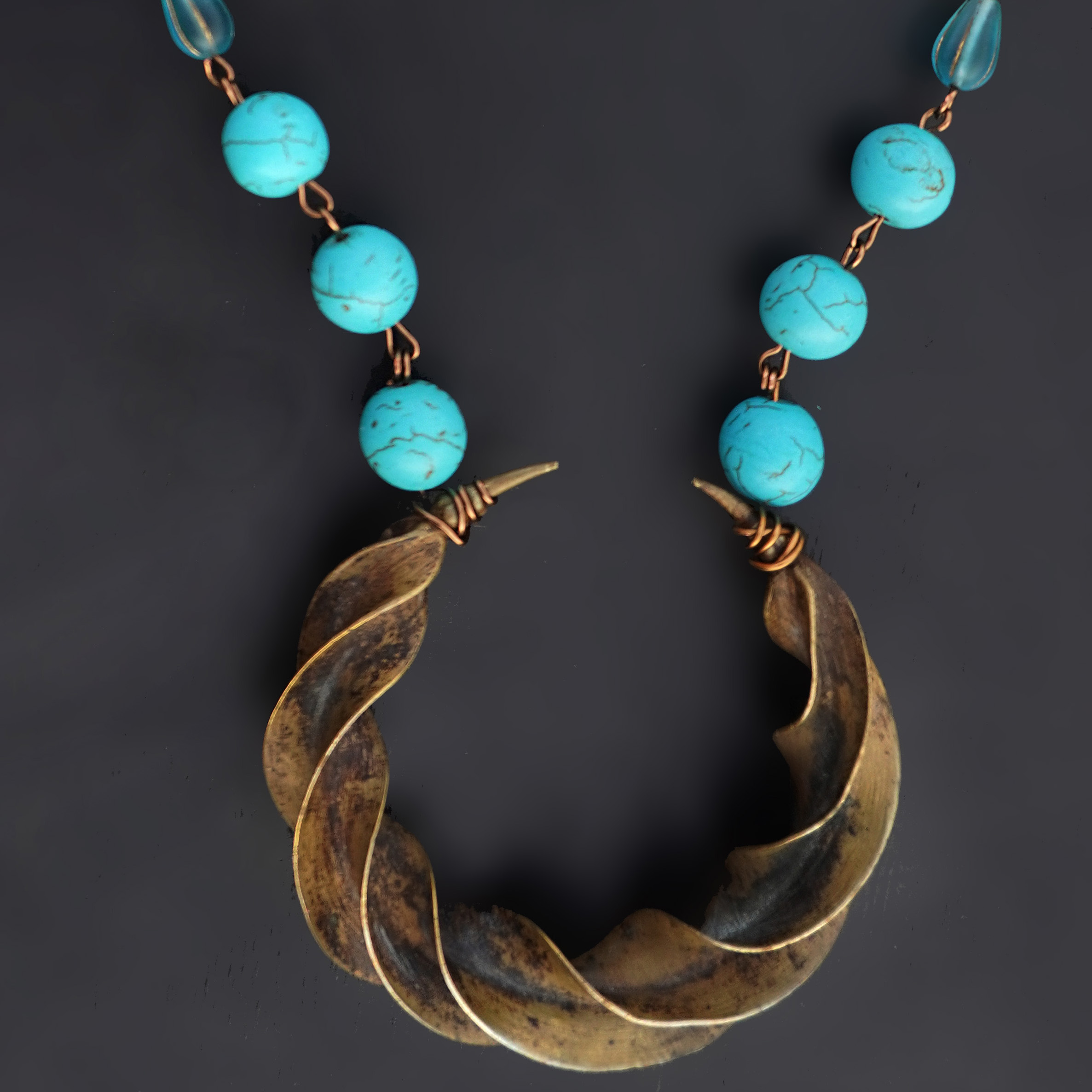I have been looking for vintage Fulani earrings to buy for my personal use. I was excited to see a few of them prop up for sale in the Virtual Souk. However, they were singles, expensive and not wearable as earrings for those without extended earlobes. I did end up buying one. Since it was a single earring and quite heavy, I turned it into a pendant for a Turquoise necklace. But before I go about showing my turquoise necklace, here is a little information about Fulani earrings and turquoise – both the gemstone and the colour.
Fulani earrings
Worn by the Fula or Fulani people in Mali in Africa, Fulani earrings or kwottenai kanye are often made by twisting sheet metal. It could be made of gold, bronze or brass. The earrings are a part of their bridal trousseau as explained by Keith Andrew in this old Bridal Series post on African Bridal jewellery. At the present, extremely thin metal is used to keep the earrings light weight, particularly for the tourist market. However, the one that I have is heavy and is meant to elongate earlobes or to be worn on extended earlobes.

When I got the earring, I knew that I wanted to create a striking necklace using it. My initial plan was to incorporate the red thread that you see on the Fulani earrings as a wrap for the pendant and to use red and gold beads. However, for a heightened contrast, I looped it with turquoise beads using antique brass artisan wire.

The History and Significance of Turquoise
Turquoise is a gemstone prized for its beauty and spiritual significance for thousands of years. It is a blue-green mineral that is typically found in dry, arid regions around the world. The geological history of turquoise spans an impressive 40 million years, making it one of the oldest gemstones used in jewellery. It has various religious connotations. It was often worn as an amulet or talisman to ward off evil spirits and promote good fortune. Egyptians believed that turquoise was their connection with the many Gods and Goddesses in heaven.
Native American warriors wore turquoise to battle because they considered it a protective stone. Navajo, Zuni, and Hopi tribes of the southwestern United States have a long history of using turquoise in their jewellery designs.. It is treasured in Tibet and China for its good luck and healing properties. Turquoise, along with coral set in silver, is considered to have divine powers and is worn during temple festivities and weddings.

Turquoise is a hydrated copper and aluminum phosphate mineral that forms in the presence of water. Its name is derived from the French word for Turkish, “Turquois” as it was first introduced to Europe through trade routes from Turkey. However, turquoise is found in many regions around the world, including Iran, Kazakhstan, China, and the United States.
Turquoise Colour – What makes Turquoise, turquoise?
The colour of turquoise is determined by the presence of copper, aluminum, and phosphorous in the mineral composition. The most common colour of turquoise is a greenish-blue, but it can also range from pale blue to deep green, with a wide range of tones and shades in between. The exact ratios of these elements can vary depending on the location where the turquoise was formed, which can result in different shades and hues of blue and green. In general, the more copper that is present in the turquoise, the bluer it will appear. Higher levels of aluminum, on the other hand, can result in a greener hue. Additionally, the presence of other minerals like iron, zinc, and calcium can also influence the colour of turquoise, leading to a range of variations.

Turquoise can also have a matrix or webbing pattern of veins or specks, which can be a different colour than the base stone. This matrix can be black, brown, or golden in colour, and can add character and interest to the gemstone. Read about the psychology of turquoise colour here. Did you know that turquoise and its cousin teal are the colours of beads that I have most received during a bead swap? See my turquoise and copper necklace from 2018 bead swap with Lori here.
Cuts and shapes
The gemstone can be cut and polished in a variety of shapes and sizes, from smooth cabochons to faceted gems. Turquoise beads are available in nugget form, as discs as well as smooth beads. It will do you well to remember that not all nuggets are natural and not all rounds are reconstituted, synthetic or even replacements such as dyed magnesite and Howlite.

Turquoise necklace and a Fulani earring as a pendant
I hope you enjoyed reading about turquoise. Here is a picture of the necklace and earrings set that I made. While I typically make asymmetrical necklaces, I made this one symmetrical just to keep it simple. The turquoise beads that I have used are natural, but enhanced to achieve a uniform colour and shape. I have combined some agate beads and Czech glass beads with it.
My hunt for a wearable pair of Fulani earrings is still on. Until then, do tell me what you think of my necklace. Also, have you used turquoise in your designs or do you wear the stone? Tell me in the comments.
I hope you find it interesting
Cheers



What do you think?